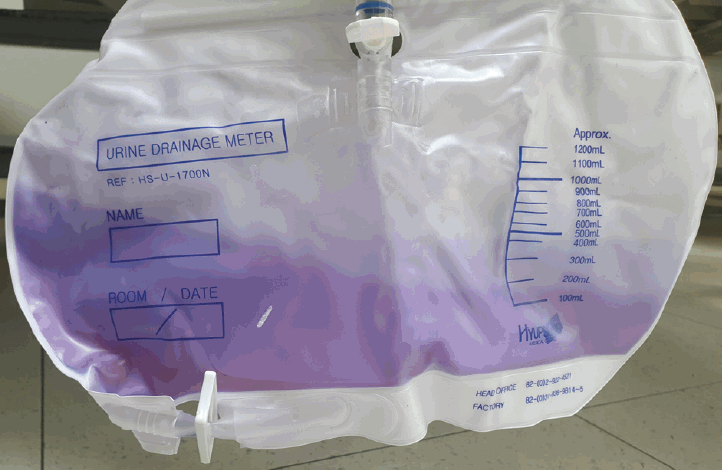자주색집뇨관증후군
Purple Urine Bag Syndrome
Article information
87세 여자가 우측 중대뇌동맥영역 뇌경색으로 입원하여 도뇨관을 유치하던 중 14일째부터 집뇨 주머니가 자주색으로 착색되었다(Fig.). 생체징후는 혈압 143/76 mmHg, 맥박수 76회/분, 호흡수 14회/분, 체온 36.5℃였다. 소변검사에서 pH 7.0, 단백뇨 및 세균뇨가 관찰되었으며 세균배양에서 폐렴막대균(Klebsiella pneumoniae)이 동정되었다. 증상은 시프로플록사신 정맥 투여 및 도뇨관 교체로 호전되었다.
자주색집뇨관증후군(purple urine bag syndrome)은 집뇨 주머니나 집뇨관이 자주색 또는 파란색으로 착색되는 현상으로 장기 입원 환자들에게서 매우 드물게 관찰된다[1]. 발생 기전으로는 Proteus mirabilis, 대장균(Escherichia coli), 녹농균(Pseudomonas aeruginosa), Morganella morganii, Klebsiella pneumoniae 및 장알균<속> (Enterococcus sp.) 같은 박테리아 요도 감염과 관련이 있다. 경구 섭취한 트립토판(tryptophan)은 장내 세균에 의해 인돌(indole)로 대사되어 문맥 순환계로 흡수된 후 인독실황산염(indoxyl sulphate)으로 분해되어 소변으로 배출되는데 이들 박테리아는 인독실황산염을 인디루빈(indirubin, 적색)과 인디고(indigo, 청색)로 변화시키는 인독실 인산염분해효소 및 황산염분해효소(indoxyl phosphatase /sulfatase)를 생성한다[1,2]. 이렇게 발생한 두 물질이 혼합되어 보라색 소변을 형성하는데 주로 트립토판 과다섭취, 신부전, 변비 및 알칼리성 소변을 보이는 고령의 여성에서 장기간 도뇨관을 유치하는 경우 발생한다[2]. 치료는 증상에 대한 자세한 설명과 함께 방광세척 및 도뇨관 교체가 우선이나 필요시 동정된 균주에 따른 항생제 투여가 필요하다[1,2].
